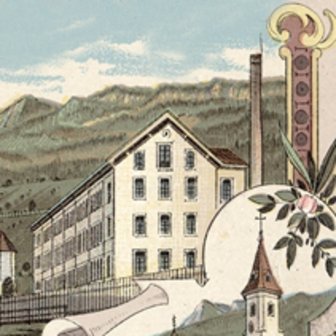ON THE INDUSTRIAL HISTORY OF LIECHTENSTEIN
For centuries, this tiny Alpine country, founded in 1719, was considered the poor relation of Europe: situated in the Rhine valley, with Austria to the east and Switzerland to the west, the principality had practically no raw material deposits of its own. Agriculture, the most important source of income until around 1930, produced almost exclusively for its own needs, the domestic market was insignificant and the capital for business enterprises was lacking.
The rising tide of European industrialisation did not reach Liechtenstein until 1836, when the Schädler tiled stove factory opened, which developed into a ceramic art company that still exists today. The customs treaty concluded with the Habsburg monarchy in 1852 finally opened up access to a larger market. In 1861, the first bank was founded and then and infrastructure was expanded for the first time: Bridges were built over the Rhine at Schaan and Bendern. The Samina Valley was opened up with a road and a tunnel in 1864, enabling the gradual emergence of Alpine tourism. Starting in 1872, trains of the Austrian railway “k.k. priv. Vorarlberger-Bahn” traversed the country, and a station was built in the capital city of Schaan-Vaduz – although it was not served by the long-distance lines between Austria and Switzerland.
Duty-free access to the Austrian market led to the founding of several weaving mills powered by fast-flowing mountain streams - particularly the operations of the Swiss entrepreneurs Caspar Jenny and Johann Jakob Spoerry. In 1905 they merged to form a major textile company that produced, with interruptions, until 1992. The imposing factory buildings in Tresen, erected in 1870, and the associated workers housing are protected monuments today.
However, this modest expansion was not sufficient to feed the population: as late as the start of the 20th century, many Liechtensteiners were forced to seek work in neighbouring countries, or to emigrate. The key to the country’s subsequent successful economic development is that the Principality sought a close relationship with its neighbour to the west following the collapse of the Habsburg Empire: with the Customs Treaty of 1923 and the adoption of the Swiss currency in 1924, Liechtenstein was integrated in the Swiss market. From the mid-1930s o, an increasing number of businesses were founded – helped by low wages and taxes. Companies werne established mainly in the metal, machinery and apparatus industries, , and many of these businesses are still in operation today.
The Scana cannery, which opened in 1935, developed into the food conglomerate "Hilcona". The mechanical engineering company Hilti, founded in 1941, today is known world-wide for its fastening technology. The economy also profited from production for German armaments. In 1941, for example, "Press- und Stanzwerk AG" set up shop in Liechtenstein. In the meantime, under the name "ThyssenKrupp Presta AG", the company mainly manufactures steering systems for vehicle construction. The "Gerätebau-Anstalt Balzers", which opened in 1946, developed into "Oerlikon Balzers", a leading company for vacuum and surface technology. In the 1950s, the country’s recently founded industries experienced dramatic growth, with the numbers of employees sometimes increasing fivefold. Some companies developed into internationally successful enterprises in the 1960s, and some even became world market leaders.
Today, industrial enterprises that are predominantly highly technical, research-intensive and almost entirely geared to exports produce about 40% of the gross domestic product. Liechtenstein is one of the most industrialised countries in the world. Nevertheless, the majority of the workforce (62%) now works in the service sector: the financial services industry in particular has become an important part of the economy. Remarkably, the Principality has more jobs than inhabitants; more than half of the employees are commuters from Switzerland and Austria.


